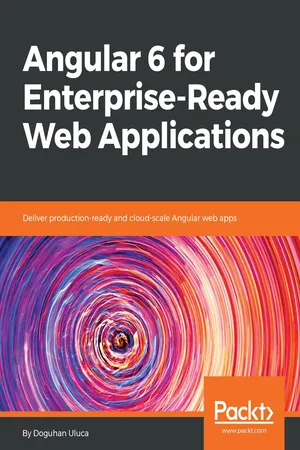
Angular 6 for Enterprise-Ready Web Applications
Deliver production-ready and cloud-scale Angular web apps
- 512 pages
- English
- ePUB (mobile friendly)
- Available on iOS & Android
Angular 6 for Enterprise-Ready Web Applications
Deliver production-ready and cloud-scale Angular web apps
About This Book
A hands-on guide with a minimalist and flexible approach that enables quick learning and rapid delivery of cloud-ready enterprise applications with Angular 6
Key Features
- Explore tools and techniques to push your web app to the next level
- Master Angular app design and architectural considerations
- Learn continuous integration and deploy your app on a highly available cloud infrastructure in AWS
Book Description
Angular 6 for Enterprise-Ready Web Applications follows a hands-on and minimalist approach demonstrating how to design and architect high quality apps.
The first part of the book is about mastering the Angular platform using foundational technologies. You will use the Kanban method to focus on value delivery, communicate design ideas with mock-up tools and build great looking apps with Angular Material. You will become comfortable using CLI tools, understand reactive programming with RxJS, and deploy to the cloud using Docker.
The second part of the book will introduce you to the router-first architecture, a seven-step approach to designing and developing mid-to-large line-of-business applications, along with popular recipes. You will learn how to design a solid authentication and authorization experience; explore unit testing, early integration with backend APIs using Swagger and continuous integration using CircleCI. In the concluding chapters, you will provision a highly available cloud infrastructure on AWS and then use Google Analytics to capture user behavior.
By the end of this book, you will be familiar with the scope of web development using Angular, Swagger, and Docker, learning patterns and practices to be successful as an individual developer on the web or as a team in the Enterprise.
What you will learn
- Create full-stack web applications using Angular and RESTful APIs
- Master Angular fundamentals, RxJS, CLI tools, unit testing, GitHub, and Docker
- Design and architect responsive, secure and scalable apps to deploy on AWS
- Adopt a minimalist, value-first approach to delivering your app with Kanban
- Get introduced to automated testing with continuous integration on CircleCI
- Optimize Nginx and Node.js web servers with load testing tools
Who this book is for
This book is for developers who want to confidently deliver high-quality and production-grade Angular apps from design to deployment. We assume that you have prior experience in writing a RESTful API with the tech stack of your choice; if you don't, you can still gain a lot of benefit from this book, which focuses on the entire scope of frontend development, from design to deployment!
Frequently asked questions
Information
Create a Local Weather Web Application
- Get introduced to Angular and the philosophy behind it
- Configuring a repository with an optimal folder structure for full-stack development
- Using Angular CLI to generate your Angular web application
- Optimizing Visual Code for Angular & TypeScript development
- Planning out your roadmap using Waffle as a GitHub-connected Kanban board
- Crafting a new UI element to display current weather information using components and interfaces
- Using Angular Services and HttpClient to retrieve data from OpenWeatherMap APIs
- Leveraging observable streams to transform data using RxJS
- For Chapters 2 to 6, LocalCast Weather, at: Github.com/duluca/local-weather-app
- For Chapters 7 to 12, LemonMart, at: Github.com/duluca/lemon-mart
Introduction to Angular

Table of contents
- Title Page
- Copyright and Credits
- Packt Upsell
- Contributors
- Preface
- Setting Up Your Development Environment
- Create a Local Weather Web Application
- Prepare Angular App for Production Release
- Staying Up to Date with Angular Updates
- Enhance Angular App with Angular Material
- Reactive Forms and Component Interaction
- Create a Router-First Line-of-Business App
- Continuous Integration and API Design
- Design Authentication and Authorization
- Angular App Design and Recipes
- Highly-Available Cloud Infrastructure on AWS
- Google Analytics and Advanced Cloud Ops
- Other Books You May Enjoy